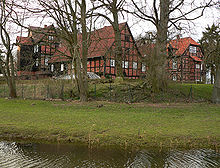Ahlden House
This article needs additional citations for verification. (January 2021) |
| Ahlden House | |
|---|---|
Schloss Ahlden | |
 Main building of 1613 and entrance to the house | |
| General information | |
| Type | Stately home |
| Location | Ahlden |
| Country | Germany |
| Opened | 1549 |
| Technical details | |
| Material | Timber-framed |
| Floor count | 2 |
Ahlden House (
It is principally known as the place of imprisonment of Sophia Dorothea of Celle, otherwise Sophie Dorothea of Brunswick-Lüneburg, wife of George I of Great Britain and the mother of George II of Great Britain.
Location
Opposite the mansion, in a
Construction


Much of the house is of
The west wing is the main building of the mansion, which Duke Christian the Elder of Brunswick-Lüneburg had built by his seneschal (Drost), Johann Behr, in 1613. On the entranceway leading to the inner courtyard the wall recesses for the drawbridge can still be seen. During the construction of the wing in 1613 there was a serious accident when a roof joist dislodged and seriously injured 14 workers.
The south wing, a timber-framed structure with brick infill, is the oldest part of the building. It was completed in 1579 under Duke
The north wing is a timber-framed structure that was redesigned in 1705 by the architect, Johann Caspar Borchmann, because the building was falling into disrepair. Outside the house there was a gatehouse and entranceway. It guarded access to the house and was demolished probably around 1800. The building is clearly recognisable on the Merian engraving of 1654 as a detached building.
Originally the castle was surrounded by a double moat and a rampart. The rampart was levelled in 1690 in order to create a French pleasure garden. The moats were filled in during the 19th century.
History


The castle's predecessor,
The princely office (
In the
The considerable renovation work required was completed in 1975 at a cost of 90,000 DM from state funds. An antiques auctions house bought the house for its representational headquarters, on the condition that the courtyard would be kept open for the public during the day. Limited viewing of the interior is only possible when previewing items for auctions.
Prison
When she was divorced from her husband in 1694 after her affair with Lieutenant Königsmarck, Sophie Dorothea of Brunswick-Lüneburg was brought to Ahlden House, where she was imprisoned until her death in 1726.[1]

See also
Notes
- ^ Sophie Dorothea's great-granddaughter Caroline Matilda, sister of George III and Queen of Denmark, shared a similar fate: after her unlucky affair with Struensee she was imprisoned in Celle Castle.
Sources and external links
- Ahlden (in German)


